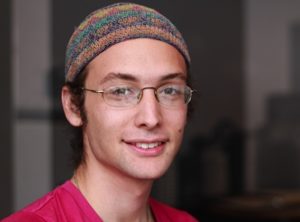Noam Sienna, a full time history PhD student at the University of Minnesota, is also a part time henna artist. We talked to him this week about the Jewish roots in henna and why he loves the practice.
How did your interest in henna first spark?
I started doing henna as an undergraduate in Boston. I had a friend who introduced me to it. Because I’m from Canada, I was an international student, so during my international student orientation, I sat next to a nice student from India and we became close friends. That semester, she took to me to a party where there was a henna artist. After I started playing around with it, another friend of mine I knew through Hillel said there are Jewish traditions to use henna. I had no idea!
Why did you decide to study the art form?
I decided to look into it, and realized there’s little scholarly attention to the subject. So I started doing more research, and collected material after about a year and a half, and realized through the advice of an academic adviser, that I should write my honor’s thesis on it. I spent the next year in Israel doing field work and interviewing elderly immigrants who’d made Aliyah from different countries and asked about their experience with henna. So since I finished that thesis, five years ago, I’ve continued to do research, write about henna and learn about henna.
How did your research turn into practice?
My research informs my art, and vice versa. There’s little work that has been done on henna, and the work that has been done hasn’t been by artists, it’s done by academics who are about it but aren’t doing it by hand. They’re not asking the right questions, they aren’t familiar enough with the materials.
 What makes henna Jewish?
What makes henna Jewish?
Partly, it’s the design. A lot of times, people ask me, “Are there Jewish designs?” or “Is there a Jewish style of doing it?” The truth is, I think what people are expecting is that the Jews drew little Jewish stars. They didn’t. If you look at Jewish art in general, traditionally speaking, folk art looked like folk art, and it’s very rare to find explicitly Jewish symbols in henna art.
If you look at photographs of a Jewish bride with henna and a Muslim bride with henna, it’s going to look pretty much the same. The difference is in the context of what happens at that henna ceremony and what the henna means and symbolizes to those people.
So how many Jewish henna artists are out there?
I don’t know a lot of Jewish henna artists who are working as a henna artist specifically as part of their Jewish practice. In Israel, there are a lot of people who organize henna parties, and many of them are from henna-using communities or learned about the trade from their parents and grandparents. At the same time, the majority of those people aren’t artists — they organize the henna ceremony, but they don’t actually do the henna. There are very few henna artists that work in Israel today.
Why aren’t there many henna artists in the Jewish community?
Largely, what it has to do with is the way the ethnicity and culture has been understood in Israel over the last 50 years. When people came to Israel, there was a period of time, where if you came from somewhere like Morocco or Yemen, your culture wasn’t valued the same way as if you came from Europe. People were ashamed, or they wanted to blend in; they wanted to let go of the “old country.” That generational gap means that I, now, as a third generation, have to go back deep to their roots. A lot of people are going back now to have a hyphenated identity. And as much as that’s exciting, there’s been a huge loss in cultural literacy.
What is the most rewarding part of making henna art?
For me, the most rewarding part of this work is that it’s really an honor. It puts me into context with people at these times in their lives which are so momentous — mostly happy times, but also not so happy times. Being able to help them through that big change in this time of transition and say, “Here’s something from our tradition which might help you do that.” — it’s tremendously moving. I’ve done ceremonies for weddings, births, deaths, Bar and Bat Mitzvahs, and every time, it is incredibly meaningful for me to be able to be involved with it.


